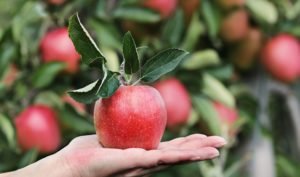
The apple is a delicious and crunchy fruit with thin skin (pericarp), thick inner flesh (exocarp) and a core that contains seeds. It comes in green, yellow, red, russet, and dark red colors. It is grown worldwide, particularly in temperate regions.
The apple is perhaps the most recognized fruit that finds its place and mention in many religious texts, from Greek, Roman and Norse mythologies and Abrahamic scripture to forms of popular literary culture such as folktales, poetry, proverbs, phrases and symbols. Interestingly, the larynx in the human throat is also called the “Adam’s Apple.”
This essential fruit requires a temperate climate, loamy soil that is rich in organic matter apart from needing proper drainage and aeration facilities. All such conditions are fulfilled for apple growth here in Kashmir, so much so that we have developed an entire history and a tradition of apple cultivation.
From such a history, we know that Sultan Zain-ul-Abidin (1420-1470 AD) paid considerable attention towards the valley’s agricultural base while constructing many famous water channels. He also imported several fruit grafts from various parts of Central Asia, particularly from Iran. Subsequently, the Moguls also played their part and laid out parks, gardens and orchards in different places across the valley.
Sir Walter H. Lawrence in his
famous book The Valley
of Kashmir (1895) has
also mentioned that “Kashmir
is a fruit producing country.”
Kashmiri apples have a unique look, taste, flavor, size and color. The apple is one of the most important fruit crops, cultivated almost in every part of the valley, and as such a source for the economy and the local fruit industry. However, the major producers of apples are districts like Shopian, Baramullah, Kulgam, Pulwama, Budgam, Anantnag, Srinagar, Kupwara and Doda.
Varieties
The complete genome of an apple was sequenced in 2010 (the Golden Delicious kind with 57,000 genes), which helped researchers develop high-yielding, fast-growing and disease-resistant apple trees. Currently, there are more than 7,500 varieties of apples grown worldwide and only six varieties of apples are commercially cultivated across the valley of Kashmir, including the following:
Amber – this red, medium-sized fruit becomes fully ripe in mid-October. It is mostly grown in Shopian and Kulgam.
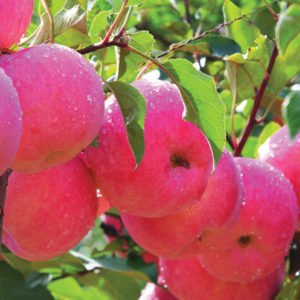
American Trel – a small, rounded, very crispy and sweet fruit variety that ripens in mid-September.

Red Delicious – a very popular and widely cultivated variety of apple that ripens in mid-September. Its flesh is greenish white, grainy and juicy.

Maharaej – a large apple with red and green color. It tastes a bit sour but sweetens with time and is available by late October.
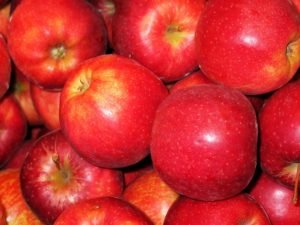
Hazratbael – a quickly perishable variety that ripens in early July. It is the oldest variety of apples cultivated in the valley and is mostly consumed domestically.
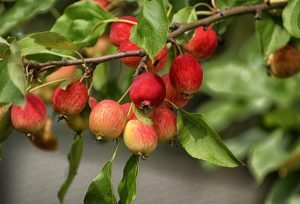
Golden Delicious – a variety with comparatively longer shelf life, it is crispy, juicy and has thick greenish-white flesh which turns golden upon ripening. It is available till January.
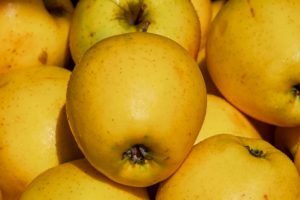
Some other varieties of apples have also been introduced in valley over the last few years. Such varieties are: crimson, Bulgarian, M9 and other HD varieties.
Plantation Methods
Apple seeds are sown in nurseries during the December-January cultivation window. In two or three years, the plants grow four to five feet long. These, however, are called “Jungli plants.” It is only after grafting or budding, a vegetative method of reproduction, that apple trees start bearing fruit in their full capacity.
Budding (cheshim) is a technique carried out in the month of July-August in which a wild plant bark at a certain location is cut in a ‘T’ shape and a bud taken from a high-yielding tree is inserted into it and tied back.
Grafting (paiwand) is a technique used in early March where the wild plant is cut at the stem 2 to 3 feet above the ground and the small two scions of high-yielding plants are inserted into it. Twigs are also planted and later grafted in the same manner, albeit rarely.
Land Preparation and Spacing Patterns of Plantation
A pit of size 2x2x2 feet or 3x3x3 feet is dug before the month of plantation in mid-November. After a month, the grafted plants are planted in it between December and April.
Spacing varies from place to place and species to species. For the varieties of Red Delicious, Amber, Golden Delicious, etc., a planting distance of 6×6 meters or 7×7 meters is followed while 4.5×4.5 meters is suggested to be good for other dwarf varieties like M4, M7, M9, M107, the Crimson, and the Bulgarian kind.
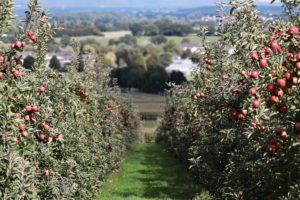
Nutritional Supplement
Nutritional doses vary as the plants grow older. In the first year, as the buds appear after grafting or budding, four to five kilos of decomposed farmyard manure is added annually around the base of the plant. The advent of the green revolution and specific developments in chemical agriculture have allowed cultivators to mix 50 grams of urea with the same base, thereby improving the plant’s health. Goat and sheep pellets (Munann) are mostly preferred and suitable as compost for fruit plants. Adult trees are applied with 10 to15 kilos of decomposed manure at the root, and 500 grams of Nitrogen, 250 grams of Phosphorus and 400 grams of Potassium are applied annually on the same root.
In their early years of growth, beans, potatoes, tomatoes and peas are cultivated as intercrops under apple trees which help in making the soil more fertile and supplement income by allowing alternate cultivation. However, this practice is abandoned when the trees start bearing fruits (after 6 to 8 years).
Weed Removal
Weeds (invasive small plants) growing around the base of the apple tree are removed usually by hand or if possible by tilling. To halt their further growth, farmers spread dry leaves, dry paddy grass and oak leaves around the base. This also helps in enriching the soil and is effective in conserving soil moisture.
Flowering and Leaves
Flowering occurs simultaneously with the budding of the leaves. Serrated, oval-shaped leaves of dark green color and flowers of white color with a pink tinge grow in full bloom in the month of late March. Orchards in this spell attract the attention of any passerby, while butterflies, bees and insects of other kind gather around, exhibiting the glory of the cultivation season as a majestic sight to behold. Blooming buds and flowers bring joy to the farmers as these are signs of a high quality yield in apples that also translate to a high number of produce (which in turn guarantees more income).
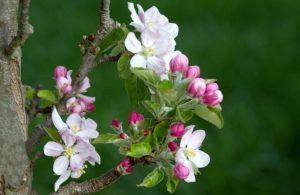
Irrigation
Hilly and dry areas require irrigation 10 to 15 times annually while plain areas require it less. Irrigation means supplying water to an orchard artificially. When orchardists observe and feel that the soil is not moist enough to meet the water requirements of the plant, farmers supply water to these orchards by canals connected to any nearby stream. In areas where streams are not found wells are dug deep and water is fetched using mechanical motors. The valley Kashmir is situated in the subtropical and sub- temperate latitudes and is characterized by great variations in terrain and altitudes and as result the annual rainfall, temperature and humidity is irregular and non-uniform.
Pollination
Pollination is the process of transferring pollen grains from the anther to the stigma of the flower to develop fruit. Apple flowers are not compatible enough to self-pollinate and therefore must be cross-pollinated to develop quality fruit. Even though pollination is carried out mostly by many natural agents like the honey bee, ants, wasps, rainfall, wind, and butterflies, most of the orchardists adopt another method of pollination using flower-bearing twigs from certain specific pollination trees like the Golden Delicious, or Maharaej which are cut and put in bottles filled with water that are then left hanging on the fruit trees. Also, few pollinated trees are planted at certain places in the orchards.
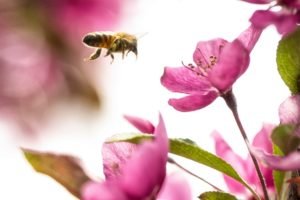
Insects, Pests and Diseases
Apples are prone to many fungal and bacterial diseases and pests. The most common pests are the San Jose scale, the Wooly Aphid, the Red Mite, the Powdery Mildew, and Blossom Thrips. These fungi and pests affect leaves, flowers, shoots, buds, bark and overall the entire plant. These diseases are controlled by spraying specific pesticides, fungicides and insecticides.
Diseases like collar rot, apple scab and crown gall can potentially cause significant damage to apple trees. Application of suitable fungicides like Copper Oxychloride, Carbendazim, Mancozeb are effective in controlling these diseases. Furthermore, mice, birds and bears also affect the trees and their fruit. Apple orchards and maize fields attract bears in particular, with bear attacks at such sites being reported. Proper fencing methods should be implemented to protect these natural predators as well as the orchards and the fields as well.
Challenges and Alternatives
Though chemicals including fertilizers, pesticides, insecticides, hormones, fungicides, herbicides, and weedicides are applied to fruit trees to boost productivity, their prolonged, frequent and injudicious use results in various environmental and human health problems. Most of these chemicals are non-biodegradable and leave poisonous residues. In addition, fruit trees become weak and susceptible to various pests and diseases, resulting in reduced vitamins, minerals and other essential nutrients in the season’s yield. Research has shown that crops, fruit and vegetables grown in chemically fertilized soils have less magnesium, potassium and calcium content. Also, research conducted globally has revealed that most of the fruit and other crops have become contaminated. These products, distributed for consumption, carry inappropriate quantities of harmful chemicals that enter the human body and create many serious health problems like cancer.
As an alternative, shifting to organic farming can present benefits and deter fruit cultivation from becoming harmful not only for human consumption but also for the environment. Organic farming is the method of growing crops and fruit by making use of bio-fertilizers and bio-pesticides. However, in our valley this method of farming is yet almost unknown and as such, it is imperative that the government introduce this method among the growers and promote awareness by providing financial aid and practical know-how by organizing workshops and programs from time after time.
Uses
Apples are consumed across the world as the fourth most widely purchased fruits after bananas, oranges and grapes. The entire fruit, except the core that may contain toxic seeds, are consumed raw, as parts of salads, as slices, baked in pies and cakes, pressed to produce juice, cooked into sauces, as jams, made into apple butter. Jewish people dip apple slices in honey and eat them during Rosh Hashanah, the Jewish New Year. Interestingly enough, in our valley thin apple slices (Tsunth Hach) are dried and consumed widely in the winter and early spring.
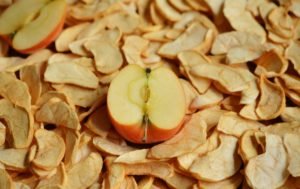
Apple Picking
Apple picking is done manually in its entirety. The apples are left on the open ground under shade for a few days for the moisture to dry and the fruit to cool. Then pedicles are cut so that they do not harm apples pressed together in packed boxes, followed by a grading procedure. Apples are graded usually on the basis of size in three to five grades (numbered one to five). Apple trees start bearing fruit normally from the eighth year and the yield keeps on increasing till the fifteenth to eighteenth years and thereafter the quantity of apples borne remains constant. Newer species of apple trees like Crimson, Bulgarian, Hybrids and so on start bearing fruit after the second year of being planted.
Small plastic buckets and deep baskets are hung on branches or simply kept in hand to collect apples while picking. A tripod ladder is also used where branches are spread too far to reach the fruit. This job requires skill and patience as one has to sit in one place for hours. Apples are packed in four or five layers and each layer is covered with dry paddy grass in wooden boxes or CFB (Corrugated Fiber Board) cartons. A box carries an average weight of 18 kilograms.
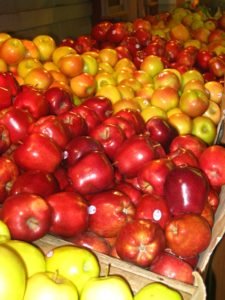
Supply
Kashmir valley leads in the supply of apples within the Asian subcontinent, with an annual export of 70% of the total production. Kashmiri apples are supplied to most of the states of India and other foreign countries.
Sopore mandi, Asia’s second largest fruit market, acts as a hub where hundreds of wholesalers gather and negotiate prices with the growers since most of the valley’s produce is sold to these wholesalers. Some growers also sell their produce to the local retailers. Others manage to send their produce outside of the valley.
A good portion of apples consisting of early droppings, varying in size and color, and deemed unsuitable for sale in packaged boxes are supplied to the local juice factories located mostly in the Lassipora area of Pulwama district. The juice is supplied to local markets while the extract is used as cattle feed.
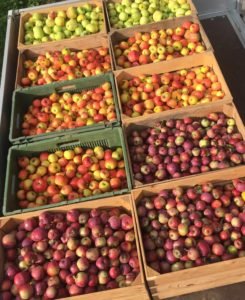
Nutritional Value
A long list of health benefits is attributed to apples. Apple contains essential vitamins (vitamins A, B1, B2, B3, B5, B6, B9, A, C, E and K) and water, energy, calcium, magnesium, phosphorous, manganese, iron, potassium, carbohydrates, zinc, dietary fiber, carotene, lutein, and low traces of fat, sodium, and protein. Being rich in fiber, apples assist digestion and ensure smooth bowel movement, thus preventing constipation while also reducing the chances of breast and colon cancer. Since apples are rich in iron, they help in treating anaemia as well. The potassium found in apples helps in controlling the heart rate and blood pressure and thus reduces the risk of strokes. Apples also improve the functioning of the beneficial bacteria in our large intestine.
The anti-oxidants present in apples help in reducing the risk of Alzheimer’s and Parkinson’s disease and help in improving memory. Apples have also shown anti-inflammatory powers and thus assist in treating asthma, arthritis and gout while boosting the immune system. Finally, apples are beneficial in bone and teeth health, and they satiate hunger, serving as an ideal food for weight loss. Apple-based pastes and creams increase skin texture and their juices when applied to the scalp prevent dandruff.
Storage
As an apple ripens it softens and becomes more juicy and tasty. Apples have a comparatively long storage life of 4 to 8 months after being picked and stored according to the right ambient and temperature conditions. Commonly, apples are kept below 30 C in chambers with a good concentration of carbon dioxide.

Pruning
Pruning is the method of trimming and thinning of buds to provoke proportionate budding of new flowers so that fruit develop equally on all the possible branches of the tree.
Areas under Cultivation
Horticulture crops covering a variety of temperate fruit and nut species like apple, pear, peach, plum, apricot, almond, walnut, cherry and grape, is gaining momentum as there has been a tremendous increase in the area of cultivation. The total area under apple cultivation was 98,929 hectares in 2004-5, it increased to 126,641 in 2010-11, and in 2016-17 it rose to 144,825 hectares.
Total Production
Apple production worldwide in 2016 was 89.3 million metric tons. In that same year, China was at the top of the list with almost 50% of the world’s produce coming from its orchards, farms, and crops. In our valley, even though cultivation is a labour-intensive job, income per kanal is much higher than any other crop. Apple cultivation has been playing a vital role in improving the standards of living, per capita income and employment generation as almost half of the valley’s total population (more than 33 lakh) is directly or indirectly engaged with it in various ways, from its cultivation, storage to its transport, marketing, etc. As such, it would not be wrong to say that horticulture is the backbone of Kashmir’s economy with an annual income of about Rs. 8,500 crore (2017), which translates to horticulture contributing about 24.5% of the GSDP from about 8% of the area while the agriculture sector contributes about 14% to the GDP (Gross Domestic Product) and 20.59% to the GSDP (Gross State Domestic Product) and still the main source of livelihood for most of the rural population. In 2004-5 the production of apples was 1,082,817 metric tons and in 2010-11 it was 1,828,786 metric tons, rising to 1,921,057 metric tons in 2015-16.
Current Challenges and the Road Ahead
Since apple cultivation has attracted everyone’s attention, now and each year tens of thousands apple trees are planted and each year thousands of kanals of irrigated land, paddy in particular, are converted into horticulture land (orchards). Experts say that this shift has adversely affected the hydrological cycle in the valley as paddy fields transformed into orchards would retain water for months in their original form and thus replenish the levels of groundwater. The shrinking of paddy fields at a rapid rate is also contributing to a higher possibility of floods.
Possible Solutions for Optimal Efficiency
- It would be very beneficial to introduce some mechanical methods for apple picking as it would save both labor and time.
- Availability of an easy and affordable transport facility is a must for growers so that they send their produce to the markets on time, especially since they are handling perishable goods.
- There should be a cold storage facility available at the marketplaces and mandis.
- Governments should encourage a cooperative marketing system.
- Training and techniques of manure, spraying, disease control, precautions should be occasionally organized in various districts, tehsils and villages.

